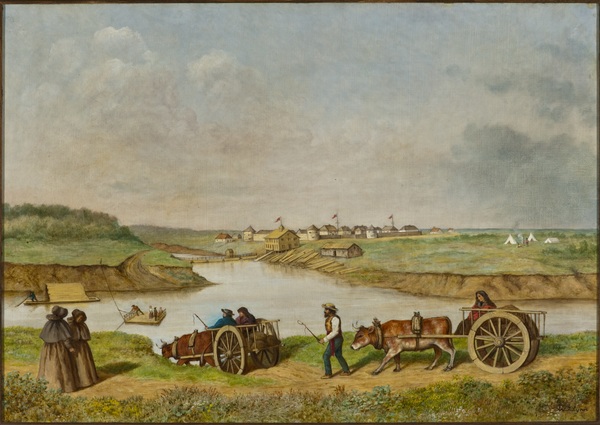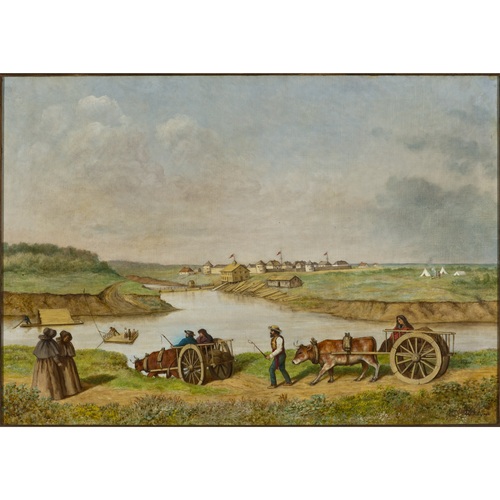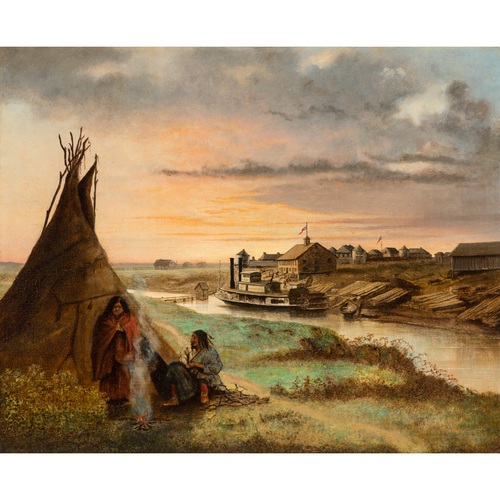
Source: Link
LYNN, WASHINGTON FRANK, artist, journalist, and author; b. c. 1827 or c. 1837 in Chelsea (London), England, second son of William Bewicke Lynn; m. 2 Sept. 1874 Elizabeth Charlotte Tarren in Winnipeg, and they had two sons and a daughter; d. there 20 July 1906.
Washington Frank Lynn’s father was a medical officer during the Peninsular War and a surgeon at Westminster Hospital, London. His brothers included a well-known astronomer and a civil engineer. After preliminary training Lynn became a probationer in the schools of the Royal Academy of Arts in June 1859, was promoted student in December 1860, and continued for about one year.
Late in 1861 Lynn went to North America; until 1864 he followed the events of the American Civil War as a newspaper reporter, sending articles to the Toronto Globe. His travels awakened in him an interest in British emigration, and on his return to England he found employment with the Canadian Land and Emigration Company of London. In connection with his work he accompanied families from England to the Haliburton and Muskoka districts of Ontario in 1868, gathered information useful for settlers, and, back in London the following year, published Farming in Canada and Canada: pamphlets for working men.
In order to evaluate the Americans’ aggressive promotion of Kansas and Nebraska for British immigrants, Lynn visited the region in late 1871 and early 1872. In letters to the Globe he criticized the climate, the system of land allotment, the high taxes, and the malarial conditions he found there. The Royal Colonial Institute of London, which he had helped found in 1868, was probably responsible for directing his attention to the Canadian northwest as an alternative to the United States. In the spring of 1872, soon after having attended a meeting of the institute concerning Manitoba, he departed for the northwest via Kansas. He had originally intended to report his findings to the institute in October, but arrived in Manitoba too late to return to London for that purpose. Interested in the varied composition of the province’s society, he stayed on, thinking that he would “find enough to employ both pen and pencil for some time.”
Lynn’s informative letters continued to appear in the Globe. He also began a series of paintings, among them The forks of the Red and Assiniboine, The Dakota boat, Fort Pembina, Fort Pelly, Archbishop Taché [Alexandre-Antonin Taché*], and The Barber house, all dating from 1872 to 1877. Lynn’s work is that of a professional who combined a fine sense of colour and composition with a keen eye for the significant features of his subjects. Although adequate, his genre figures are less successful. Most of his later paintings were variations of these earlier pieces. The popularity of Lynn’s work is demonstrated by the number of versions extant.
In the autumn of 1872 Lynn’s letters in the Globe took on a political tone. Openly accusing several officials of corruption, including dominion lands agent Gilbert McMicken* and surveyor general John Stoughton Dennis*, he called for a federal investigation of the Manitoba offices of the dominion lands branch of the secretary of state, protection of claims held by early settlers, and changes in the Dominion Lands Act to limit the acreage allotted per person and to stop speculation on grants to volunteers. He also felt that the Métis should be permitted to choose the location of their grants rather than be lumped together in townships. While his charges, backed by Globe editorials, resulted in some improvement, Lynn became unpopular with the Winnipeg establishment. His relationship with the Toronto paper ended in 1873; in that year and the next he wrote for the Manitoban and was briefly editor of the Nor’ Wester and the Standard, all of Winnipeg. He also entered the real-estate business with John O’Reilly, forming the Lynn and O’Reilly Land and Real Estate Company in 1875.
Increasingly disillusioned with Winnipeg, Lynn left the city. In 1878–79 he lived in St Paul, Minn., and from 1881 to 1885 he was in London, England, where he may have acted as an immigration agent, but these attempts at relocation were apparently unsuccessful. After his return to Manitoba in 1885 he opened a grocery store, which eventually became a notions shop run by his wife, Elizabeth Charlotte. Late in life he sold one of his properties, on which the T. Eaton Company’s store would be built, at a considerable profit. He maintained an involvement in politics, running unsuccessfully for the position of alderman on the Winnipeg City Council in 1885, 1888, and 1889; he became an active member of the Knights of Labor, arguing against monopolies and advocating social reform; and he wrote many letters on local issues to the press. When he died, he was described as a “man of refined taste” and a reformer who did much for Winnipeg’s good, although never in an official capacity. Today he is best known for his able paintings, which are now valuable historical records.
Washington Frank Lynn’s paintings can be found at the AASB, the Glenbow Museum (Calgary), the offices of the Hudson’s Bay Company (Toronto), the PAM, and the Winnipeg Art Gallery.
Lynn is the author of Canada: pamphlets for working men on emigration, labor, wages, and free grants of land (London, 1869) and Farming in Canada, or, life in the back woods, ed. Ellen Barlee ([London?, 1869?]), as well as of numerous articles published in the Globe: 24 Dec. 1864; 8, 10, 13 Feb., 12, 19, 22 July, 9 Sept., 17 Oct., 6, 15 Nov., 2, 7, 11, 17, 20, 30 Dec. 1872; 29 Jan., 11, 14 Feb. 1873.
AASB, Fonds Taché. PAM, MG 11, E1. Royal Academy of Arts (London), Students’ reg. Manitoba Morning Free Press, 21 Sept. 1878, 15 Dec. 1885, 12 Dec. 1888, 8 Nov. 1889, 8 Sept. 1891, 31 July 1906. Telegram (Winnipeg), 21 July 1906. V. [G.] Berry, “Washington Frank Lynn: artist and journalist,” Beaver, outfit 308 (1977–78), no.4: 24–31. Directory, Man. and N.W.T., 1886–94. William Johnston, Roll of commissioned officers in the medical service of the British army . . . (Aberdeen, Scot., 1917). 150 years of art in Manitoba, comp. Ferdinand Eckhardt (Winnipeg, 1970). Royal Colonial Institute, Proc. (London), 3 (1871): 125.
Cite This Article
Virginia G. Berry, “LYNN, WASHINGTON FRANK,” in Dictionary of Canadian Biography, vol. 13, University of Toronto/Université Laval, 2003–, accessed December 12, 2025, https://www.biographi.ca/en/bio/lynn_washington_frank_13E.html.
The citation above shows the format for footnotes and endnotes according to the Chicago manual of style (16th edition). Information to be used in other citation formats:
| Permalink: | https://www.biographi.ca/en/bio/lynn_washington_frank_13E.html |
| Author of Article: | Virginia G. Berry |
| Title of Article: | LYNN, WASHINGTON FRANK |
| Publication Name: | Dictionary of Canadian Biography, vol. 13 |
| Publisher: | University of Toronto/Université Laval |
| Year of publication: | 1994 |
| Year of revision: | 1994 |
| Access Date: | December 12, 2025 |




